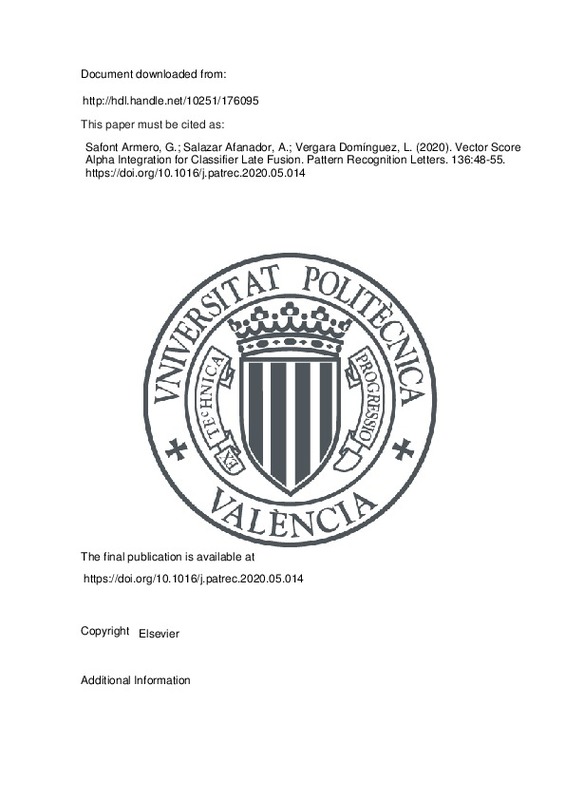JavaScript is disabled for your browser. Some features of this site may not work without it.
Buscar en RiuNet
Listar
Mi cuenta
Estadísticas
Ayuda RiuNet
Admin. UPV
Vector Score Alpha Integration for Classifier Late Fusion
Mostrar el registro sencillo del ítem
Ficheros en el ítem
| dc.contributor.author | Safont Armero, Gonzalo
|
es_ES |
| dc.contributor.author | Salazar Afanador, Addisson
|
es_ES |
| dc.contributor.author | Vergara Domínguez, Luís
|
es_ES |
| dc.date.accessioned | 2021-11-05T12:27:32Z | |
| dc.date.available | 2021-11-05T12:27:32Z | |
| dc.date.issued | 2020-08 | es_ES |
| dc.identifier.issn | 0167-8655 | es_ES |
| dc.identifier.uri | http://hdl.handle.net/10251/176095 | |
| dc.description.abstract | [EN] Alpha integration is a family of integrators that encompasses many classic fusion operators (e.g., mean, product, minimum, maximum) as particular cases. This paper proposes vector score integration (VSI), a new alpha integration method for late fusion of multiple classifiers considering the joint effect of all the classes of the multi-class problem. Theoretical derivations to optimize the parameters of VSI for achieving the minimum probability of error are provided. VSI was applied to two classification tasks using electroencephalographic signals. The first task was the automatic stage classification of a neuropsychological test performed by epileptic subjects and the second one was the classification of sleep stages from apnea patients. Four single classifiers (linear and quadratic discriminant analysis, naive Bayes, and random forest) and three competitive fusion methods were estimated for comparison: mean, majority voting, and separated score integration (SSI). SSI is based on alpha integration, but unlike the proposed method, it considers the scores from each class in isolation, not accounting for possible dependencies among scores corresponding to different classes. VSI was able to optimally combine the results from all the single classifiers, in terms of accuracy and kappa coefficient, and outperformed the results of the other fusion methods in both applications. | es_ES |
| dc.description.sponsorship | This work was supported by the Spanish Administration and European Union under grant TEC2017-84743-P. | es_ES |
| dc.language | Inglés | es_ES |
| dc.publisher | Elsevier | es_ES |
| dc.relation.ispartof | Pattern Recognition Letters | es_ES |
| dc.rights | Reconocimiento - No comercial - Sin obra derivada (by-nc-nd) | es_ES |
| dc.subject | Classification | es_ES |
| dc.subject | Machine learning | es_ES |
| dc.subject | Decision fusion | es_ES |
| dc.subject | Alpha integration | es_ES |
| dc.subject | EEG | es_ES |
| dc.subject | Apnea | es_ES |
| dc.subject | Epilepsy | es_ES |
| dc.subject | Neuropsychological test | es_ES |
| dc.subject.classification | TEORIA DE LA SEÑAL Y COMUNICACIONES | es_ES |
| dc.title | Vector Score Alpha Integration for Classifier Late Fusion | es_ES |
| dc.type | Artículo | es_ES |
| dc.identifier.doi | 10.1016/j.patrec.2020.05.014 | es_ES |
| dc.relation.projectID | info:eu-repo/grantAgreement/AEI//TEC2017-84743-P-AR//METODOS INFORMADOS PARA LA SINTESIS DE SEÑALES/ | es_ES |
| dc.rights.accessRights | Abierto | es_ES |
| dc.contributor.affiliation | Universitat Politècnica de València. Instituto Universitario de Telecomunicación y Aplicaciones Multimedia - Institut Universitari de Telecomunicacions i Aplicacions Multimèdia | es_ES |
| dc.contributor.affiliation | Universitat Politècnica de València. Departamento de Comunicaciones - Departament de Comunicacions | es_ES |
| dc.description.bibliographicCitation | Safont Armero, G.; Salazar Afanador, A.; Vergara Domínguez, L. (2020). Vector Score Alpha Integration for Classifier Late Fusion. Pattern Recognition Letters. 136:48-55. https://doi.org/10.1016/j.patrec.2020.05.014 | es_ES |
| dc.description.accrualMethod | S | es_ES |
| dc.relation.publisherversion | https://doi.org/10.1016/j.patrec.2020.05.014 | es_ES |
| dc.description.upvformatpinicio | 48 | es_ES |
| dc.description.upvformatpfin | 55 | es_ES |
| dc.type.version | info:eu-repo/semantics/publishedVersion | es_ES |
| dc.description.volume | 136 | es_ES |
| dc.relation.pasarela | S\433103 | es_ES |
| dc.contributor.funder | AGENCIA ESTATAL DE INVESTIGACION | es_ES |







![[Cerrado]](/themes/UPV/images/candado.png)

